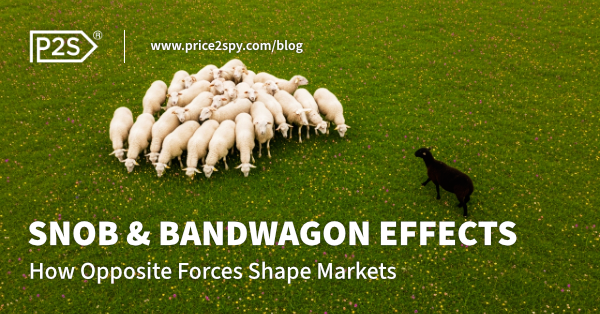
Snob Effect vs Bandwagon Effect: How Opposite Forces Shape Markets
Consumer choices are rarely made in isolation. More often than not, what we decide to (or not to) buy depends on what others around us are doing.

The phenomena we are going to talk about in this article answer the questions such as:
- Why do some people stop buying some products when they see other people buying them?
- Why do some people only start buying some products when they see other people buying them?
- What is the psychological effect that keeps the fashion industry afloat?
- What about consumer electronics? Is it the same or perhaps something completely different?
Both situations we talk about in this article have one thing in common. They are purchase decisions based on whether other people are buying a product or not.
Let’s talk about the snob and the bandwagon effect.
Bandwagoning (Bandwagon effect)
The snob effect is the opposite of the bandwagon effect.
Snob effect describes a purchase decision making process in which people will generally do the opposite of what the masses are doing.
Because of this, it is sometimes referred to as ‘reverse bandwagoning’.
People described by snob effect will seek unpopular and “under-the-radar” products; products which generally people aren’t aware of.
However, scarcity (whether artificial or natural) usually isn’t enough. The product also has to have a certain quality standard, perhaps come from a certain brand, or meet other buyer’s criteria.
One thing to note is that practicality, usually isn’t among the top criteria for snob buyers.
Primary psychological motivations behind snob effect are:
- status signaling;
- desire to differentiate yourself;
- scarcity bias;
- relating identity to purchases.
In Which Industries is the Snob Effect Most Common?
The common thread between industries in which snob effect is common is that exclusivity is the main value-driver of a product. Symbolic value outweighs practical value.
It’s not difficult to think of examples. Art, jewelry, high fashion, and even sports cars, are all industries in which this effect is popular.
Most of these products are deliberately scarce, either because materials are rare or because brands intentionally limit supply.
Their price tags serve less as a reflection of production costs and more as signals of prestige and status.
Where Does Pricing Come In?
Snob Effect and Prices
The snob effect is deeply linked to product pricing. High prices prevent a large number of people from purchasing a certain item.
This is why the snob effect can cause an actual drop in demand when the prices drop. This is a noticeable exception to the supply and demand rule.
The key question in the customer’s mind in this case is “What does owning this product say about me?”
Bandwagon Effect and Prices
The value for the “bandwagon” buyers lies primarily in participating with others. Getting the most for your money, finding the right set of features, meeting a certain quality standard, and similar, usual motivating factors play a secondary role here.
Prices are important in the sense that they can, if too high, limit the number of buyers. However, the desire of consumers to be a “part of the tribe” can make room for somewhat higher prices than usual. How higher will depend on what industry, customer segment, and type of product we are talking about.
Conclusion
Hopefully, now you understand the difference between the snob effect and the bandwagoning effect.
At the end of the day, whether we’re talking about the snob effect or the bandwagon effect, both remind us of something simple: our choices don’t happen in a vacuum.
We look around, notice what others are doing, and it shapes the way we see value. Sometimes we want to stand apart, sometimes we want to belong.
In both cases, our purchases say something about who we are and the people around us.



